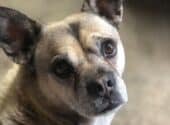Pugs, those little bundles of snorting joy, never fail to make us laugh. But just like us, they can also be at risk of carrying a few extra pounds. If you’re unsure of the signs of obesity in dogs, don’t worry. We’re here to answer your weighty question: “How Do I Know If My Pug Is Overweight?”.
By the end of this informative guide, you’ll know very well the difference between a perfectly healthy Pug and an overweight cuddle buddy.

What Is The Ideal Pug Weight
Variables such as age, gender, and body composition may yield slight discrepancies in the ideal weight of Pugs; however, for healthy adult ones, a range between 14-18 pounds (6.3 – 8.2 kilograms) is generally considered suitable to maintain the breed’s unique physique and preventing health risks related to being underweight or overweight.
Pugs require optimal weight to stay in proportion with their size to maintain skeletal and muscular health. If they become too thin or frail, they are prone to developing serious issues. Carrying more weight than recommended may cause obesity leading to potential health risks.
How To Determine If My Pug Is Overweight
- An overweight Pug may demonstrate several recognizable signs of an unhealthy weight. These conditions are most easily observed by a thick layer of fat accumulating on the body, particularly in the neck, chest, and stomach regions. This extra fat can give the breed a bulgy look. You may be unable to feel the ribs due to the excess fat accumulation.
- Pugs that are overweight may not have a distinct waistline and, as a result, can take on a straight or barrel-shaped figure. Excess weight can lead to increased skin stretching, which then causes folds and wrinkles around the face and neck areas.
- Changes in behavior may suggest that a Pug is carrying excess weight. Issues such as fatigue or an inclination to participate in fewer activities may present themselves as the extra pounds strain their joints and cause discomfort. When going for walks or when it is time to play, they tire sooner than usual and show reduced enthusiasm. Additionally, due to their short snouts, Pugs naturally experience respiratory difficulties, so too much additional fat could lead to excessive panting, which intensifies with the minimal effort exerted.
- Excess body weight in a Pug can prevent them from adequately grooming themselves, as they may struggle to reach certain areas of their body. This can lead to skin irritations or infections and cause an undesirable appearance through the lack of cleanliness. Also, their coat will be dull, greasy, or matted if not brushed regularly.
- A Pug carrying too much weight can be observed via its eating patterns and portion sizes. If the animal tends to consume amounts larger than what is advised or consistently begs for more food, this indicates that it is likely gaining weight at an unhealthy rate. Thus, keeping track of the dog’s meals and ensuring that they adhere to a balanced diet appropriate for its age and activity level is crucial.
Health Risks Associated with Obesity in Pugs
Obesity has become an increasingly worrying problem for humans and animals alike, Pugs not excluded. These dogs are genetically predisposed to accumulating weight due to their remarkable appetite and reduced fitness demands.
Orthopedic Complications
Excessive weight can put a Pug’s skeletal system under considerable strain, thus elevating the risk of developing orthopedic conditions such as arthritis and joint dysplasia. If untreated, these conditions can cause persistent pain and hinder mobility, diminishing their quality of life.
Respiratory Challenges
One of the risks to Pug’s health associated with obesity is decreased respiratory capability. The brachycephalic structure of these dogs already hinders airways, and excess weight amplifies this by adding a layer of fat to the trachea and chest area, further restricting breathing passages. Troubled respiration, snoring, and increased vulnerability to heatstroke are all prevalent repercussions of carrying too much body mass in Pugs.
Cardiovascular Issues
An abundance of extra body fat can burden the cardiovascular system of an overweight Pug, forcing the heart to work overtime to supply oxygen and blood throughout the body. This can lead to hypertension and severe cardiac episodes. These diseases can gravely affect the Pug’s well-being, resulting in a shorter lifespan.
Metabolic Disorders
Pugs that carry extra body weight are in danger of developing the same metabolic problems as obese dogs, such as diabetes. This results from the excessive accumulation of body fat, impairing insulin production and functionality. They may also suffer from liver disease, pancreatitis, and hormonal imbalances that further disrupt their metabolism.
Skin and Coat Issues
The extra layers of fat on overweight Pugs can impede proper circulation, restricting the supply of nutrients to the skin and hair follicles. This makes these dogs more susceptible to skin infection, irritation, and other dermatological issues.
Tips for Managing Your Pug’s Weight
Maintain Proper Portion Control
A Pug’s metabolism is slower than the average breed, so caloric intake should be closely monitored. Overfeeding can cause a Pug to gain weight significantly faster than other breeds, leading to numerous health issues. Thus it is important to provide appropriate portions which allow for a balanced diet rich in nutrients without promoting excess consumption and, consequently, obesity. Maintaining portion control will ensure moderation in caloric intake and your pup’s health.
Choose High-Quality Food
Ensuring your Pug is nutritionally balanced with high-quality dog food is imperative to its health. Select a formula specifically designed for small-breed dogs to meet these unique requirements. Using food with controlled calorie intake will ensure that your Pug receives the vital nutrients it needs without consuming excessive calories.
Furthermore, particular attention should be paid to including dietary fiber when selecting high-quality dog food. Not only does fiber aid in controlling weight and mitigating overeating behaviors by providing more satiety, but it also helps to maintain healthy digestion and promote regular bowel movements. The implications of inadequate fiber content are considered when attempting to achieve a healthy body condition score for this breed; therefore, an optimal balance is essential.
Select trustworthy dog food brands that take rigorous measures to ensure their products are of the highest quality. Such brands often uphold strict manufacturing standards and are involved in intense testing to ensure maximum safety.
Keep Treats in Moderation
Overindulging your Pug with treats can dramatically increase their risk of weight gain. Thus, you must be careful about the quantity and size of your snacks. Give treats with a low-calorie content or use portions from their daily food ration to train them during sessions.
Be sure to select treats that are specifically developed for dogs. These snacks generally provide more nutrition while containing few calories. Moreover, they provide benefits such as dental health support, joint health reinforcement, and essential nutrients.
Provide Regular Exercise and Mental Stimulation
Even though Pugs are small, they still need daily physical activity to expend calories and keep their muscles in shape. Going on walks or playing active games each day can be suitable activities; likewise, agility and obedience training may also contribute to their fitness routine if appropriately tailored to the breed’s unique anatomy. One must be wary of strenuous exercises due to a Pug’s brachycephalic structure, which is known to obstruct its breathing patterns when overexerted.
Monitor Pug’s Weight and Body Condition
Closely monitor the weight and physical condition of your Pug consistently. Weigh them utilizing scales at regular intervals, and assess their body condition by examining their waistline and feeling their ribs.
Why is this so important?
Maintaining accurate records of a Pug’s weight is essential to determine if its dietary needs are adequately met. If their weight has increased, it could signify that too many calories are consumed or insufficient exercise is undertaken. Similarly, if they have lost weight or are in poor physical condition, then chances are that their diet may be inadequate and insufficient in its balance of nutrition. Altering their diet according to these observations can help retain an optimal body weight while guaranteeing the proper nourishment for your Pug.
Additionally, tracking a Pug’s weight is key to preventive health care. If there is marked weight loss, this may reflect a serious ailment or digestive issues. Similarly, sudden weight changes could signify hormonal disruptions or other medical complications. Routine monitoring enables early recognition and the opportunity to consult veterinary advice promptly, raising the odds of successful treatment outcomes.
Limit Table Scraps
Maintain a healthy diet for your Pug, and do not give in to the temptation of sharing human food. High-fat and sugary items will likely result in weight gain and potential digestive problems. Therefore, it is recommended that Pugs stick to their balanced meals rather than consuming leftover human foods to avoid any unwanted health complications related to obesity.
Offering table scraps to Pugs can foster unhealthy dietary patterns and conditioned begging. Pugs often captivate their owners with their endearing eyes and comical expressions, thus making it significantly harder to refuse them. Nonetheless, this can result in an inability to maintain discipline surrounding meal times in the future.
Provide Regular Veterinary Check-ups
schedule regular appointments with the veterinarian to track your dog’s weight management progress. Doing so will enable your vet to accurately monitor their weight, craft dietary plans tailored specifically for them, and identify potential health issues that may result in excessive fat gain. Partnering with your vet makes you confident your Pug will remain in optimum health and form.
Conclusion

To ensure a Pug’s mental and physical health, its body condition must be monitored carefully.
Healthy Pugs should have a visible waistline, ribs that are easily distinguished beneath thin layers of fat, and an overall proportional shape. Conversely, overweight Pugs may demonstrate round or bulging figures, lack of clear definition around their waists, fat deposits in certain areas, noticeable signs of decreased activity levels, and potential breathing problems associated with excessive eating habits.
Consult with your veterinarian if you suspect your Pug is overweight. Your vet can offer guidance on nutrition and exercise tailored to your pup’s needs. Don’t wait any longer – take action right away!





This iconic Rainbow Daytona showcases high-end craftsmanship with its gradient sapphire dial .
Crafted in 18k white gold , it merges precision timing features with dazzling visual appeal .
Available in small batches , this timepiece captivates luxury enthusiasts worldwide.
Daytona Rainbow prices
The meticulously set gems on the bezel produces a dazzling rainbow effect that stands out uniquely.
Driven by Rolex’s in-house Caliber 4130 , it ensures exceptional accuracy for enduring legacy.
A symbol of status , the Daytona Rainbow embodies Rolex’s innovation in every detail .
Your comment is awaiting moderation.